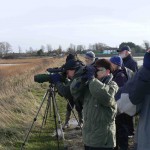The Society’s annual trip to the South Coast was on Saturday 18 January, when Ken White led a bird walk at Pagham in West Sussex. It was a mild, breezy and dry day, following weeks of heavy rain. The group gathered near the church, where there were 3 Common Buzzards disputing airspace, a good-sized flock of House Sparrows in the nearby hedge and a Fox in the next field. First stop was the sluice gate next to the North Wall of the harbour. The incoming tide was rising fast. On the remaining exposed harbour mud were Redshank, Curlew, Lapwing and Golden Plover, together with Teal, Wigeon and a solitary Little Egret. Large chuckling flocks of Russian Brent Geese flew between the flooded fields and the harbour. A few Pintail were spotted further out, half-hidden beside a channel through the mud-flats. A huge group of waders flew up into the air, then sorted themselves into separate flocks of Lapwing and Golden Plover. The smaller and faster Golden Plover flew higher than the Lapwing and began to organise themselves into V-shaped skeins. As the Golden Plover flock twisted in the sunlight, the birds sparkled first white then golden. The cause of the disturbance was a Peregrine, which raced across sky underneath the panicking flocks. The spire of Chichester Cathedral, where Peregrines have been breeding in recent years, could be seen in the distance – was it a local bird or a winter visitor? In the flooded fields on the landward side of the sea wall were good numbers of Wigeon, Teal, Shelduck, Brent Geese and Curlew. The male Teal were displaying, stretching their heads upwards and flashing their emerald green speculums. In one of the fields, two hunched-up Grey Herons appeared to be sheltering from the wind behind the hedge. Continuing along the sea wall, a number of Black-tailed Godwits, including 2 colour-ringed Icelandic birds, were in the next flooded field. In the field beyond were a big flock of Stock Dove and several Roe Deer. On the walk back, a pair of Stonechats were watched, as they perched on a fence and dropped down into the grass to feed.
After lunch, the group set out again, this time towards the lagoon and harbour entrance. New flowers were just beginning to emerge on the suckering English Elms beside the footpath and there were a number of big Tree-mallow Malva arborea plants. On the lagoon were a surprising number of Mediterranean Gulls, mostly adults, smallish gulls with all-white wings, a pair of Goldeneye and a large collection of Dabchicks. The route then continued along the beach to the hide which overlooks the entrance to the harbour. A Red-breasted Merganser was resting in the harbour, not far from the shore. Fresh green leaves of Springbeauty Claytonia perfoliata lined the edge of the path in places. Waders and gulls packed the last remaining islands in the harbour as the high tide reached its’ peak. A large flock of about 200 Grey Plovers wheeled in flight, showing the black axillaries under their wings. As the tide began to drop, waders, including small Dunlin and Knot, moved onto the first spits to emerge from the water. At the top of the spit were big Greater Black-backed Gulls, dwarfing the smaller Black-headed, Common and Mediterranean Gulls. The lagoon was rechecked on the return walk and the group were rewarded with excellent views of a Slavonian Grebe, with the sharp line between the black cap and the white cheeks clearly visible through the telescopes. Finally, there was a brief visit to Thorney Island on the journey home, for an unsuccessful hunt for dusk-flying Short-eared Owls on the rough grassland next to the military base, but the rewards were the first Canada Geese of the day, singing Dunnock and Little Egrets going to roost. The final bird species tally was 58, but it was the birds in their swirling thousands that stole the day.
Picture by Laurie Haseler

